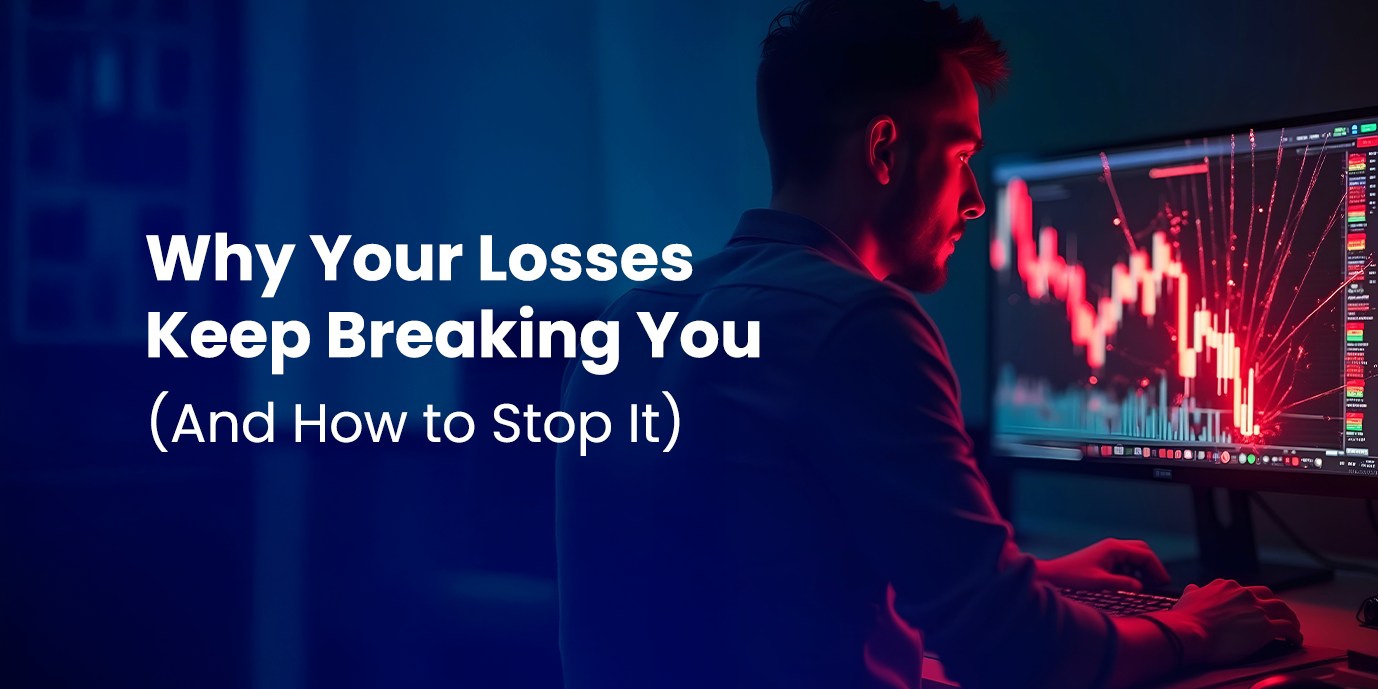Why Your Losses Keep Breaking You (And How to Stop It)
11/6/2025, 2:43:46 PM
What if your most significant trading loss could serve as a powerful catalyst for change? Discover the transformative recovery system that helped a trader bounce back from a $13,000 setback, and how it can work for you, too when you experience setbacks on your trading journey.

Every trader has that defining moment; the trading session that shakes their confidence to their very core. For one trader, it was a staggering $13,000 loss on gold in a single session. Not due to recklessness, but because emotions reigned. However, this moment transformed his trading approach forever.
Are you curious to know how? Let’s delve into how such a setback can become a springboard for growth.
Understanding Losses: It's All in Your Response
Losses are an inevitable part of the trading journey. But here’s a crucial distinction: not all losses are created equal. Paulina, our Trading Psychology Coach, emphasizes the importance of understanding the two distinct categories of trading losses:
Process-driven losses: You adhered to your trading plan meticulously, but the market simply didn’t cooperate.
Mistake-driven losses: You veered off course; whether that meant overleveraging, ignoring stop-loss orders, or making impulsive trades fueled by emotion.
Understanding this difference is vital. Every trader experiences losses, but too often they categorize every loss as a failure and every win as success. This mindset can lead to chaos. Remember: a disciplined loss isn’t a failure; it’s part of constructive trading. Conversely, a win that results from breaking your own rules isn’t success; it’s a lucky break.

The $13,000 Lesson: When Emotion Takes the Wheel
The trader in Paulina’s story came into her session devastated. He had just lost $13,000 trading gold in one day. The worst part? He didn’t even realize how it happened.
Five minutes before the New York session opened, he had no plan, no checklist, no clear setup. He saw gold moving fast and entered impulsively out of FOMO, losing $3,000 instantly.
The first loss wasn’t catastrophic, but the aftermath was. He tried to win it back. He doubled his position, ignored his rules, and lost another $10,000. Paulina guided him through a simple yet powerful audit process with four crucial questions:
Did you have a predefined setup before entering?
Did you follow your risk plan?
Was this trade part of your actual strategy?
Did you stick to your stop-loss?
With four resounding “No’s,” it became clear: this wasn’t merely a stroke of bad luck; it was a breakdown in process. Instead of feeling guilty, Paulina reframed this situation as an opportunity for growth. “If you were losing with a perfect strategy, then you’d have a real problem. But since your strategy works and your process failed, that’s a gap we can fill,” she told him. That shift in perspective was nothing short of transformative.
The Recovery Protocol: How Professionals Rebuild After Losses
Trading Psychology recovery approach isn’t about hastily jumping back into the market; it’s about methodically rebuilding your foundation. She calls this the “Loss Recovery Protocol,” which consists of three non-negotiable steps:
The Complete Trade Dissection
Open your trading journal and break down that loss. Ask yourself six probing questions:
Why did you enter the trade?
What was your pre-market analysis?
What context did you consider?
What emotions impacted your decision-making?
Where did your process begin to falter?
What would you advise another trader in your position?
The goal isn’t self-punishment or self-condemnation, but rather to cultivate self-awareness. This trader learned an invaluable lesson: if he skipped crucial steps in his process, he was setting himself up for failure. From that point on, if he lacked a checklist, it was a clear signal: no trade.
Reduce Risk and Reset Emotionally
After incurring a significant loss, the instinctive urge to “make it back” can lead to disastrous decisions. Paulina recommended he cut his position size by 50% for his next ten trades.
Why this drastic approach? Research indicates that traders often make impulsive decisions within 24 hours following significant losses. By reducing position size, he could steer his focus back to process rather than recovery. Additionally, Paulina insisted he take a complete break for 72 hours, no trading, no charts, just time to reflect. This wasn’t punishment; it was a necessary reset for his mind and nerves.
Rebuild Process, Not Ego
Upon returning to trading, the focus shifted from chasing profits to flawless execution. Paulina emphasized one key rule: “Process-driven losses are business expenses. Mistake-driven losses are system errors, and system errors can be rectified.” This mantra became his anchor.
In moments of loss, he could confidently say, “This was a business expense.” When he made a mistake, he didn’t spiral; he executed the repair protocol, focusing on process and leaving emotion behind.

The Shift That Changes Everything
After analyzing his last 100 trades, a telling pattern emerged. Approximately 30 of his losses were mistake-driven. By addressing these errors, his profitability soared, not because he became a market oracle, but because he stopped battling against himself. That’s the hidden truth of professional trading.
It’s about mastering your mind, embracing your process, and not letting losses define you. With the right framework and mindset, every trader can turn setbacks into opportunities for success. Are you ready to take the leap? Your journey to resilient trading starts now.
Congratulations to the Winner of the $100K Challenge Giveaway!
We're thrilled to announce the winner of the $100K Challenge Giveaway from the last trading psychology series:
@samir3533
Winners, please update your YouTube channel description by adding both the email address registered with FundingPips and your Discord ID. Once both details have been added to your YouTube profile, please open a Giveaway Support ticket on our Discord server to proceed with your claim.


